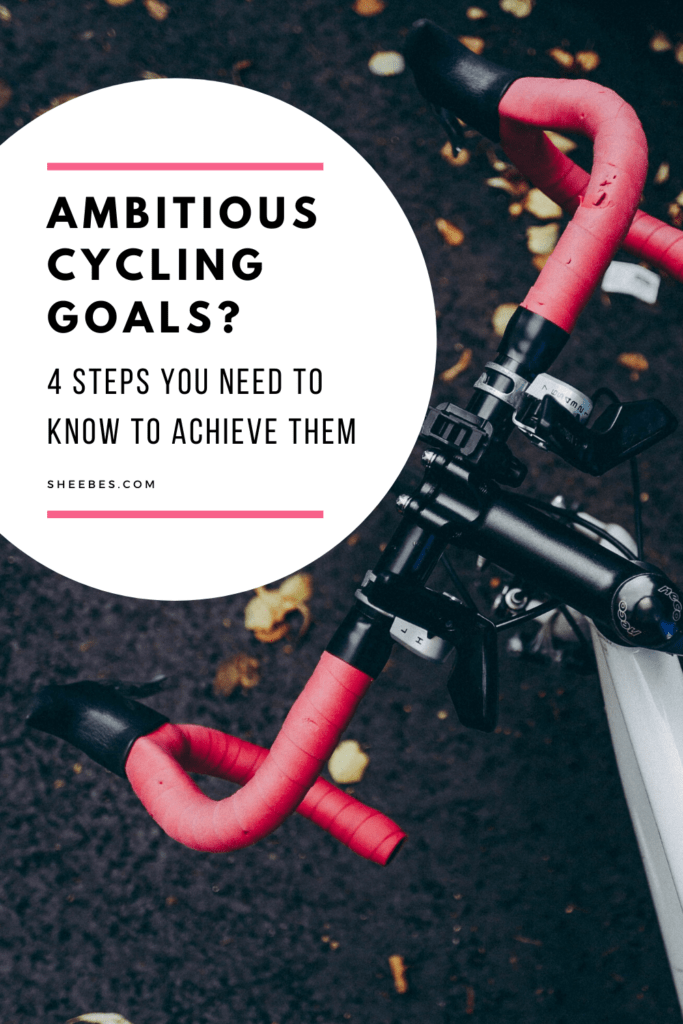Do you have ambitious cycling goals you hope to achieve?
Have your cycling goals been on your list awhile and you can’t seem to quite get there?
If you do, then you’ve got to keep reading.
Because here you’ll learn 4 tips and tricks to help you achieve your cycling goals. Oh, and the bonus side effect—it boosts your cycling motivation.

Whether you’re a runner looking for running tips or a cyclist searching for cycling advice, this site is here to help you elevate your fitness game.

Sheebes is here to give mental toughness tips and resources to help you, the endurance athlete, achieve your personal best. To keep the lights on and content free, we are a participant in the Amazon Services program and other select affiliate networks. This means if you click on an affiliate link below, Sheebes will earn a small commission, at no cost to you.
4 STEPS YOU NEED TO KNOW TO ACHIEVE YOUR MOST AMBITIOUS CYCLING GOALS
TIP #1
Decide how much time you have for cycling
How much time do you have?
You’ve got to be honest with yourself here.
That’s because it’s tempting to approach ambitious cycling goals with an all-or-nothing mindset— you have time or you don’t; you’re working toward your goals or you’re not.
But small steps are still valuable. Small efforts move you forward.
Think you don’t have time? You’ll find 3 tips on how to squeeze a ride in, even on busy days.
TIP #2
Create an if-then plan
An if-then plan, or implementation intention, is a strategy designed to help you stick to your goal.
With this plan, you’ll decide when, where, and how you’ll reach your goal.
Let’s say your goal is to ride for 5 hours a week.
Without a plan to help guide your actions to your goal, you may or may not reach it.
But when you decide in advance what to do, you commit to your goal.
So your plan might look like this…
When: Monday through Friday, you’ll ride after work, before dinner
Where: at home on the trainer (Need indoor cycling motivation? Read this.)
How: for an hour
This if-then strategy is also useful when you’re facing a tough ride and want to quit. You don’t want to miss the 4-step guide to help you through it.
TIP #3
Set a goal range
Have you ever committed to a goal you had to achieve in a specific way or you failed?
For example, your goal was to ride for 5 hours this week but you only did 3. So…fail.
But is it really? I mean, you rode for 3 hours and that’s still something.
What if, instead, you set your goal number as a range instead of a single, all-or-nothing number?
Rather than stating you’ll ride for 5 hours, you could aim to ride for 3—5.
With a single number goal, you must choose between one that’s either doable or challenging. If the number’s too low, you’ll get bored because it’s too easy. Or, if your goal number is too high, you’ll get frustrated because it’s too difficult.
But a goal range offers the best of both worlds—one that’s doable and challenging.
The lower number in a goal range—3 hours—is the least amount of time you expect to spend on your bike. It’s what you’ve done before and could easily do again.
The high end of this range—5 hours a week—is slightly out of your comfort zone and you’ll have to work harder to achieve it. (That’s where the if-then plan comes in.)
A goal range strikes a balance between attainable and ambitious.
TIP #4
Use your data
Your cycling data helps you spot patterns and trends to adjust your training to meet your goal. (You’ll also quickly see when you’re headed toward overtraining. And when you need to recover.)
Capturing your stats doesn’t have to be fancy. You could use a pen and paper (like this cyclist’s training journal), a spreadsheet, Strava, TrainingPeaks. Any method you think will be easy for you to use.
Though there’s a lot of data you could collect (and you could have fun with tracking your speed, cadence, V02 max with this bundle), you may want to start with only a few key pieces of information.
Such as:
- How did you feel?
- What workout did you do?
- What was your perceived exertion?
- How was the weather?
You can always expand on the data you wish to track later. The important thing is to log your information consistently. And the benefits? You’ll see your progress and your accomplishments.
CONCLUSION
If you have cycling goals you hope to achieve, then these 4 actionable tips will help you reach your goal.
1. Decide how much time you have for cycling.
2. Create a plan where you’ll decide when, where, and how you’ll reach your goal.
3. Set a goal range to keep you motivated (and sane) while working toward your goal.
4. Use your data to help you spot patterns and trends.
There you have it— 4 tips and tricks to help you achieve and stick with your cycling goals.
Want to stay on topic? Come on over and read this post: 3 top tips you need to know before setting cycling goals.
Sources
The Effect of Goal Specificity on Consumer Goal Re engagement

